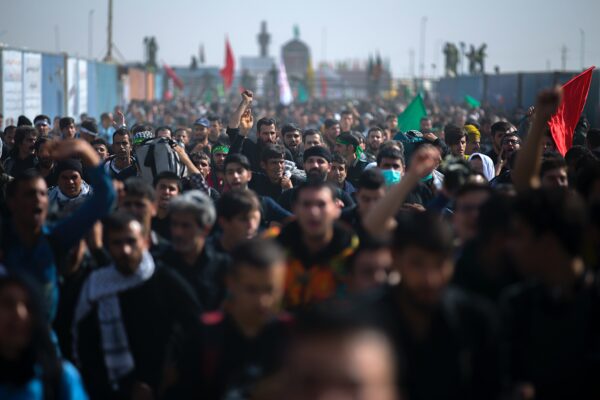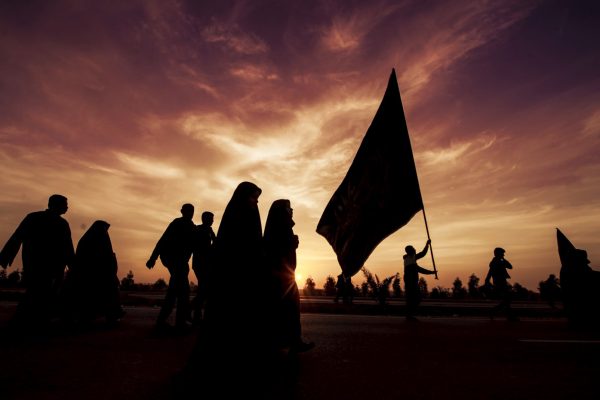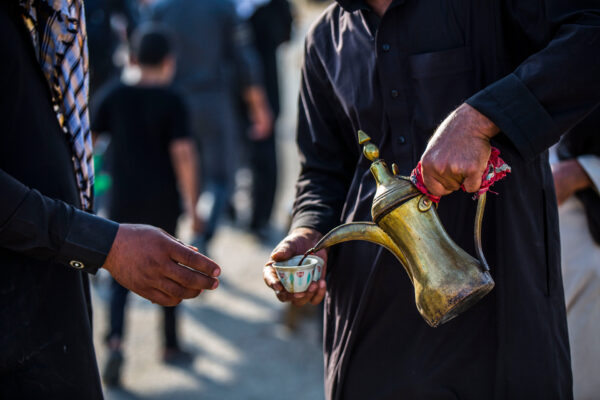The grave and its surrounding shrine have a long and storied history with numerous constructions and demolitions.
The grave and its surrounding shrine have a long and storied history with numerous constructions and demolitions.
The city of Karbala has a rich history that is both beautiful and tragic, beginning with the slaughter of Imam Hussain, his companions, and family by the army of Omar ibn Sa’ad as commanded by the Caliph of the time, Yazid ibn Muawiyah. Hussain refused to give allegiance to a corrupt leader like Yazid, and chose to die before legitimising such a tyrant’s rule. In his own words, Hussain said he was rising up “to revive the affairs of the Ummah of my grandfather”, and to “enjoin the good, and forbid the evil”.
Today, the shrine of Hussain attracts millions of pilgrims from all over the world, all over the year, who visit to pay their respects and worship Allah (swt) by his side. Architecturally it is a stunning sight, with beautiful minarets and a glorious dome housing his grave. The shrine’s courtyard extends beyond the mausoleum, which itself holds a sarcophagus in the form a dharih – quite literally a cage that enshrines the grave of Hussain.

The grave and its surrounding shrine have a long and storied history with numerous constructions and demolitions, as well as the accompanying story of the city that surrounds it.
The Beginning
The origins of the name Karbala are contested. Some narrations mention that the Prophet Muhammad (pbuh) himself during his lifetime mentioned the definition, implying that the word was a combination of Karb (land that causes agonies) and Balaa’ (afflictions) (1). In its etymology, Karbala most likely originates from Kar Bel, or Kur Babel, meaning a group of Babylonian villages, that included Nainawa, Al-Nawawees, Al-Ha’ir (also known as Al-Hira), among others. Other opinions mention that the name originated from qarballatu, an Akkadian word, referring to a sharp headgear and thereafter changing to Karbala in Aramaic, or from the word karbalaa’, meaning the imprint of a foot on soft ground. It is said by some (in what may perhaps be folklore) that the land once included an ancient temple (or graveyard) for Christians and was famous in pre-Islamic times, as part of the cities of the historic Tusuh An-Nahrain, situated on the shore of the old Euphrates river. Some also suggest the word comes from Karb/Ail (sacred precinct of Allah), or Kaar/Bolo (the higher work). Karbala may also be derived from Al-Kirbah, meaning softness, referring to the softness of the land. At the time of the battle of Karbala, the land was uninhabited, though it was rich with water and had fertile soil.
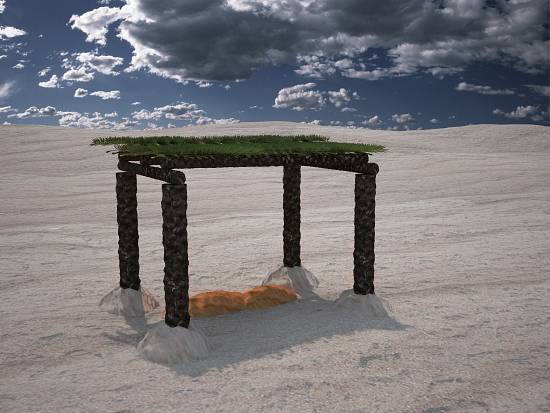
Three days after the battle of Karbala and he had been killed, Imam Hussain (pbuh) was buried by his son on the 1st (or 13th) October, 680 AD. His infant was placed on his chest and his elder son at his feet. Bani Asad, a tribe who lived on the outskirts, assisted with burying the martyrs, and a tree was planted to indicate the grave of Imam Hussain. Until today, its old location is indicated by a door to the shrine called ‘Baab Al-Sidrah’ (gate of the tree). The grave was visited by both travellers and local tribes, many of whom either stayed behind or asked relatives to bury them there after death, essentially beginning what would become the city of Karbala.
Mukhtar Al-Thaqafi, a Kufa-based revolutionary who led a rebellion against the Umayyads in vengeance for the death of Imam Hussain, visited the grave on the 18th August, 684, and built a mosque around the grave with a dome. It had two entrances.
Over half a century later, in 749, during the reign of Al-Saffah, a roof was built over a part of the mosque and a further two entrances were added. It was around this time that the Imams of the Shia school of thought, particularly Imam Jafar Al-Sadiq, began heavily institutionalising pilgrimages (or visitations, ziyarat) to Karbala and the grave of Imam Hussain. They did this by exalting the position of the land in Islamic thought, speaking of the blessings and healing qualities of its soil and highlighting the divine rewards pilgrims would receive by visiting. Many of these narrations are the biggest drive for pilgrims who travel from around the world to visit Karbala today. One example of such a hadith attributed to the Imams is,
“Do not avoid visiting the grave of Imam Hussain even during the days of prohibition. And one who visits him (his grave) in fear (of the enemies), Allah will give him refuge from the great fear of Qiyamah and he will gain reward proportionate to the fear. And the one who fears due to their fear, Allah will bestow him a refuge under the shade of His empyrean while he shall remain along with Imam Hussain and shall be protected from the fear of the day of Qiyamah.” (2)
While the shrine has benefitted from much construction, it has sadly suffered demolitions too. Its roof was demolished during the reign of Al-Mansur in 763. Around 787, the Abbasid Caliph Harun Al-Rashid demolished the roof and dome of the shrine, and cut down the tree that indicated Imam’s grave.
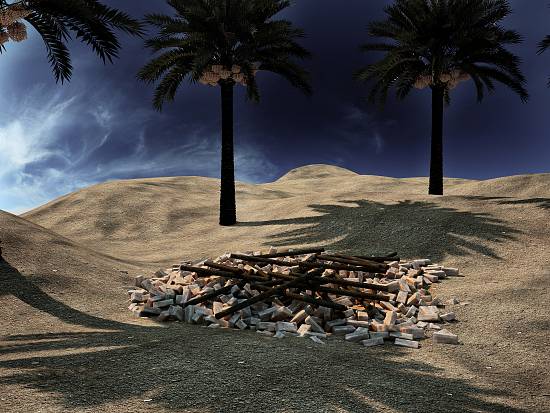
It was reconstructed in 808 but demolished completely by the Caliph of the time, Al-Mutawakkil on the 15th July, 850. He was particularly harsh on the shrine of Hussain and on its pilgrims. Aside from banning visitations, he also ordered the land to be plowed and demolished the shrine a total of four times during his reign. Some stories narrate that visitors would need to seek the scent of the grave to find it thereafter.
Al-Muntasir built a roof over the grave in 861 and set up an iron pillar near it, to serve as a landmark for the pilgrims. In 893, a dome was built in the center, with two rooves and an enclosure with two entrances.
In 981 approx, Aadod Al-Dawla, a Buyid ruler, built a dome and constructed a screen of wood around the grave (today known as the dharih). He became the first to lay the foundations for large scale construction, and built houses and markets, also surrounding Karbala with a high boundary wall. Schools and hotels also began to be built in the city. Burial in Karbala had become particularly popular the century earlier, and therefore cemeteries were also on the rise.
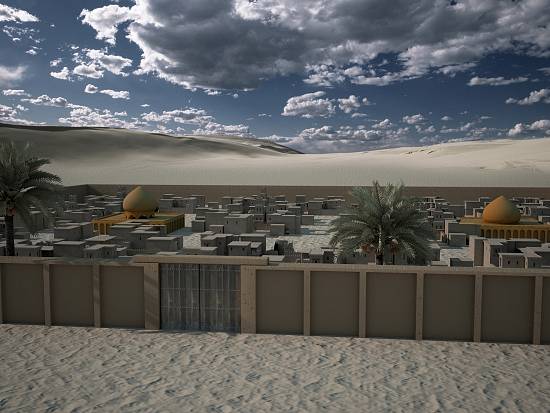
The shrines were damaged by a horrendous fire in 1016 after two large candles fell on the dharih (or on separate wooden decorations). These were rebuilt first by Al-Hasan ibn Al-Fadi, and then again by Nasir le-din-Illah in 1223. The dome was remodelled by Sultan Owais in 1365, who also extended the courtyard. Two minarets covered in gold were raised by Ahmad ibn Owais in 1384, like the minarets we see today. Ibn Battuta, the Moroccan scholar and traveller, visited Karbala in 1326.
Between Two Empires
It was in the 1500s that Karbala found itself caught in a battle between two rival empires. The Safavids, who ascribed to Shi’ism, were rising in Iran, and the Ottomans conquered Baghdad in 1533. The shrines changed hands several times, and the two brief periods the Safavids took control of the shrines resulted in mass construction and expansion, as well as the settlement of severeal thousand Persians in Karbala. The Safavids viewed the shrines as prized possessions. Shah Abbas Safavi constructed screens (dharihs) of brass and bronze around the grave in 1622. King Tahmaseb ordered the decoration of the dome of the Abbas shrine and built a dharih around the grave. The dome was whitewashed by Sultan Murad IV in 1638.
Much like the city of Najaf, Karbala had historically faced severe water shortages, to the extent that some reports suggest the city was almost completely abandoned by pilgrims in the late 1500s. This was finally resolved in the early 1700s when a dam was built at the head of the local Husayniyya canal, allowing it to enjoy a steady supply of water. Karbala then flourished, and became the center of Shia scholarship, taking the mantle from Isfahan, Iran. Together with an increase in pilgrims, Karbala improved its financial and physical infrastructure. As the Safavid empire began to collapse, there was a massive influx of Shia scholars from Persia. With the Ottoman Empire unable to keep its grip on Baghdad, scholars were able to build schools and study without much government interference. The city also enjoyed massive investments from Awadh, India during this time. The dome of Imam Hussain’s shrine was covered in gold by Shah Muhammad Qachar on the 7th July 1796.
Invasions, Occupations, and Recoveries
On the 4th May 1801 (it was on either Eid Al-Ghadir or Ashura day), Wahabis, led by Abd al-Aziz Saud, attacked Karbala, ransacking and looting the shrine, damaging the dharih and the building. They had originally tried to attack Najaf and laid it to siege, but failed to penetrate its famous walls. The Ottoman soldiers protecting the city fled, leaving between 2,000 and 5,000 Karbala inhabitants to be killed. Karbala lacked any kind of tribal army. The slaughter took about 8 hours. An eye-witness account describe the barbarity of the attack, saying,
“12,000 Wahhabis suddenly attacked the mosque of Imam Husayn; after seizing more spoils than they had ever seized after their greatest victories, they put everything to fire and sword…The elderly, women, and children—everybody died by the barbarians’ sword. Besides, it is said that whenever they saw a pregnant woman, they disemboweled her and left the fetus on the mother’s bleeding corpse. Their cruelty could not be satisfied, they did not cease their murders and blood flowed like water. As a result of the bloody catastrophe, more than 4000 people perished… they destroyed the Imam’s shrine and converted it into a trench of abomination and blood. They inflicted the greatest damage on the minarets and the domes, believing those structures were made of gold bricks.” (3)
A Wahabi account of the same attack gives a similar account:
“The Muslims [i.e. the Wahhabis] surrounded Karbala and took it by storm. They killed most of the people in the houses and the markets. They destroyed the dome above al-Husayn’s grave. They took away everything they saw in the shrine and near it, including the coverlet decorated with emeralds, sapphires and pearls which covered the grave… Nearly 2000 people were killed in Karbala.” (4)
Fath-Ali Shah, who was Shah of Iran at the time, was fiercely critical of the Ottomans for failing to confront the Wahabis. While they refused his offer of Iranian troops to defend the town, he sent 500 families to settle in Karbala with the intention of defending it. Following the attack, a wall was built around the city to protect it against attacks, and the scholars of the city established a self-governing republic. The shrine itself recovered from the initial damage inflicted by the Wahabi invasion. Shah repaired the dharih and plated it with silver in 1817. He also plated the shrine with gold and repaired damage to it.
The autonomy was ended when the Ottomans sacked the city in the 1840s and reimposed their rule over it. The Ottomans had regained direct Ottoman control over Baghdad the decade earlier, and the new Ottoman governer, Najib Pasa, was determined to take control over the city. At the time, Karbala was heavily controlled by gangs, who themselves demanded protection money from the city’s inhabitants and pilgrims. These gangs refused to accept Ottoman control, and the Ottomans sieged the city, killing around 5,000 people and desecrating the shrines. It is mentioned in some texts that the massacre was so severe that one had to walk over bodies in order to cross the street. One scholar mentions seeing bodies left clinging to the dharih of Abbas ibn Ali.
“The dead were lying on top of one another to the extent that I could not cross the street except by walking over the corpses. It was as if I walked about invisibly, so many had perished… At the foundation of the mausoleum of our master Abu’l-Fadl ‘Abbas… I descried all about the illumined sepulchre murdered souls clinging to it, beseeching, seeking shelter and refuge within it. I saw most of the dead in the lanes and bazaars.” (5)
Thereafter, many scholars moved to Najaf, which took up the mantle of the center of Shia scholarship. The Ottomans, while not interfering in scholarly organisations, imposed a tighter grip on the city. Karbala began to recover with donations coming in once again from Awadh. The money would be transferred by the British and distributed to descendants of the nine leading scholarly families in Karbala, the custodians of the shrines, students and the poor. Money was also allocated for poor Indian residents, which attracted an Indian populace.
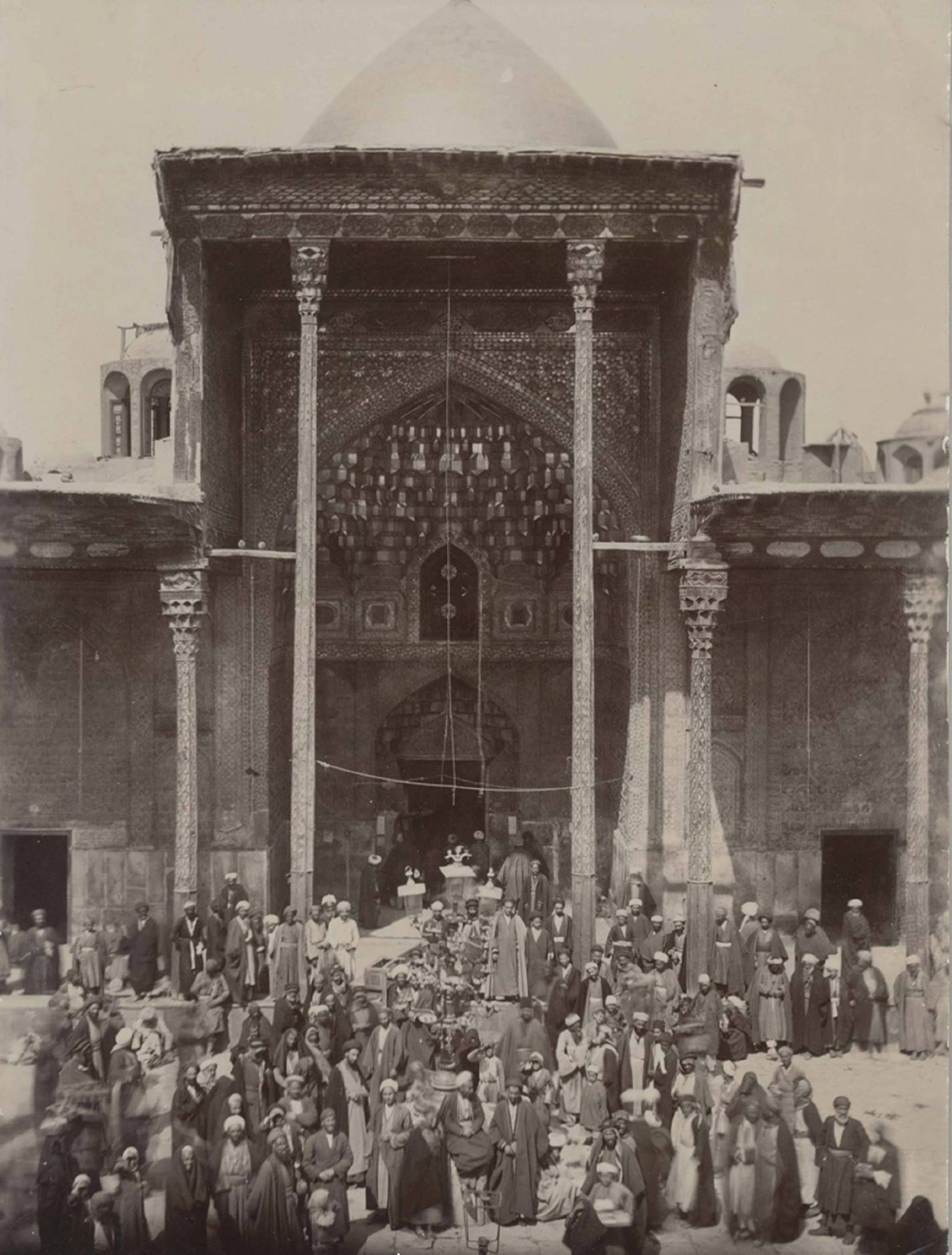
By the early 20th century, Persians made up 75% of the city’s population. Around this time the city was effectively run by the Kammuna family, who were relatives of the Shah in Iran. Under their leadership, the city did not see much of World War I, as the Kammuna family had established contacts with the British and therefore enjoyed self-governance. The Ottomans tried to regain control in 1916 but were driven out by inhabitants. The city’s autonomy ended when the British Empire took over in 1917 and drove the Kammuna family out of power. The British introduced laws that were intended to push the Persian community out, one such example was banning foreigners from holding government posts. The Persian community was reduced to 12% of the city’s population by the 1950s, and were thereafter assimilated into the Iraqi population.
A rebellion against the British was led by a group of scholars in the 20s, which included Mirza Mohammed Taqi Shirazi, who famously issued fatwas demanding the boycott of British tobacco.
Ba’ath Rule
Karbala saw some of its darkest days under the rule of the Ba’ath party and Saddam Hussein. The extreme secularist movement excluded Shia Muslims from senior positions in government and led repressive measures against Shia institutions, eventually executing leading figures in the seminaries and expelling Iraqi Shias to Iran. Commemorations of Ashura were banned, with those seen to commemorate openly risking imprisonment and execution. Spies in the city reported anyone who remotely criticised the republic. Many fled the country or were imprisoned, tortured, or killed.
A revolt against the regime took place in Southern Iraq in 1991, with Karbala for a short period of no more than 2 weeks enjoying autonomy. Flyers were dropped by American planes calling for Iraqis to rise up against Saddam. Saddam’s forces crushed the Karbala revolt brutally in 1991, desecrating the shrines and killing all who sought refuge in them. The shrine of Imam Hussain was also shelled with mortar fire. Some bullet holes still remain today, kept there as a reminder of what happened.
Thereafter, the regime was especially harsh on Karbala. After the United Nations imposed sanctions on Iraq, Karbala suffered disproportionately.
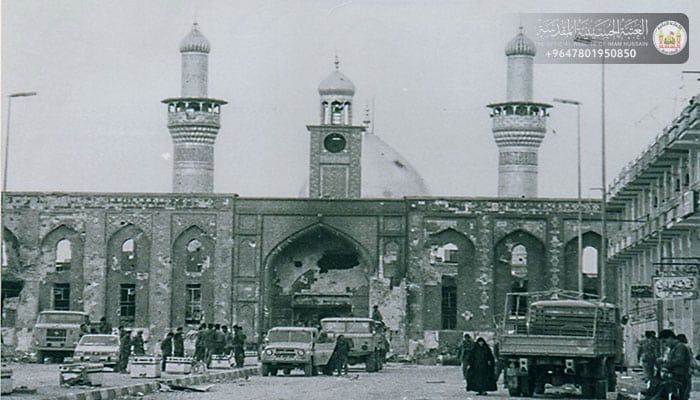
2003-Present Day
After the 2003 U.S. led invasion, Karbala enjoyed freedom once again. Many Karbala natives who had been exiled or had fled returned to see family or to settle once again. Iran poured massive amounts of funds into the renovation of the shrines and the infastructure of the city. Unfortunately, in the aftermath of the invasion, it suffered several attacks in the form of suicide bombings and car bombings by Al-Qaeda, and later ISIS. Despite this, the city recieved millions of visitors and pilgrims from around the world.
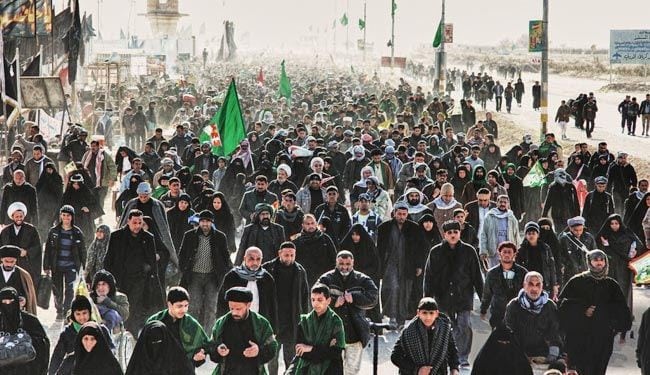
In 2017, 13.8 million people visited Karbala and the shrine of Imam Hussain for the Arbaeen pilgrimage, making it the biggest annual pilgrimage in the world.
Sources and Further Reading
- History of the Shrines
- Hussaini Centre for Research
- Encyclopedia Iranica
- The Shi’is in Iraq, Yitzhak Nakash
References
-
- Kaamil Al-Ziyarat, Shaykh Abbas Al-Qummi
- Nafasul Mahmum, Relating to the Heart Rendering Tragedy of Karbala, Shaykh Abbas Al-Qummi
- J.B. Rosseau, Pachalik du Baghdad Suivie d’une Notice Historique sur les Wahabis
- Ibn Bishr, Unwan al-Majd, Vol. 1, pp. 121–122
- Mafia, Mob and Shiism in Iraq, pg. 137, Cole, Juan Ricardo I and Moojan Momen
